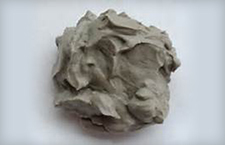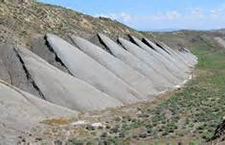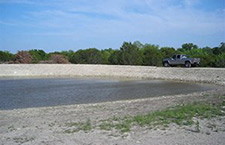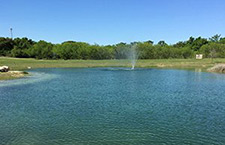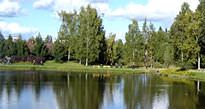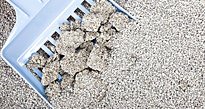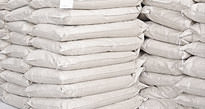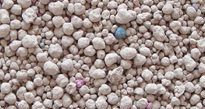Application Guide for Bentonite Pond Sealant
Water seepage can be a major problem during the pond construction process. If the soil, on which you have constructed a water body, like a small pond, is porous, it is likely that your pond will experience high rates of water seepage. Porous soil and gravel is littered with small holes and gaps that allow water to flow through. Over time, water from the pond will slowly seep into the soil and leak away, causing a variety of problems. Applying bentonite pond sealant during construction or later to fix leaks is an effective way to combat water seepage problems.
The following chart can help you know how much bentonite pond sealant is required per square foot of area to be sealed. The chart is based on water depths of up to eight feet. For ponds deeper than eight feet, it is recommended increasing the application of bentonite pond sealant by one pound per square foot for each additional eight feet of depth.
PRIMARY SOIL TYPE:
Clay Soil
AMOUNT OF POND SEALANT REQUIRED:
1.0 to 1.5 lbs per sqf
PRIMARY SOIL TYPE:
Sandy Silt 20% Clay Min
AMOUNT OF POND SEALANT REQUIRED:
2.0 to 2.5 lbs per sqf
PRIMARY SOIL TYPE:
Silty Sand
AMOUNT OF POND SEALANT REQUIRED:
3.0 to 3.5 lbs per sqf
PRIMARY SOIL TYPE:
Clean Sand
AMOUNT OF POND SEALANT REQUIRED:
4.0 to 4.5 lbs per sqf
PRIMARY SOIL TYPE:
Rock Or Gravel
AMOUNT OF POND SEALANT REQUIRED:
5.0 to 6.0 lbs per sqf
For more information about applying bentonite pond sealant to your pond or to talk with our experts about any questions you may have about clay bentonite, contact us today!
Important Information About Pond Sealant Application Techniques
Applying pond sealant to a pond is not a simple process. There are a number of factors that you must consider before choosing the best method of application. Your application method will depend on the dimensions of the pond, the depth of the pond, and the current conditions of the pond. Moreover, the type of soil may also affect the pond sealant application method. There are three primary techniques for applying pond sealant. These are:
The Blanket Method for Bentonite Pond Sealant
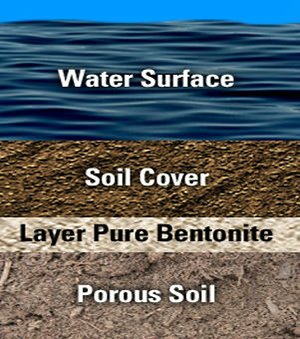
This method of applying bentonite pond sealant typically produces the most success and remains the most popular. The first step of the procedure involves clearing any debris from the surface to be treated such as large rocks, dead vegetation, and roots. Once this has been completed, you must remove approximately 5 inches of soil from what will become the pond’s waterbed.
Next, you should use a combination of bentonite and soil to fill in any deep holes, gaps, and crevices along the pond’s surface, in a ratio of 1 part bentonite to 5 parts soil. Once all holes are covered and packed smooth, a layer of bentonite should be applied evenly over the entire waterbed. This should be spread as evenly as possible. Finally, the 5 inches of soil that was initially removed should be replaced. The pond is now ready to be filled with water. A gentle water flow is recommended to prevent eroding the soil or bentonite layers.
The Mixed Blanket Method for Bentonite Pond Sealant
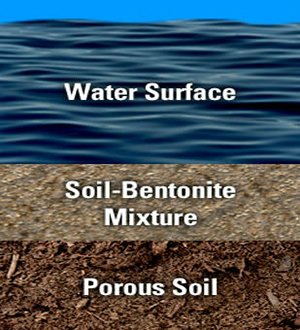
This method of applying pond sealant is similar to the blanket method. However, there are some key differences to note. For example, if this method is to be used, the waterbed of the pond must be tilled between 4 and 8 inches deep after the area has been cleaned of debris. The soil must then be dragged until the surface is smooth. This process will ensure that the soil remains consistent all along the waterbed.
The bentonite pond sealant should then be applied evenly across the soil using a seed or fertilizer spreader. It is important to ensure even application during this process. The pond sealant should then be mixed well with the soil. This can be managed effectively through tilling, disking, and raking. Once this has been accomplished, the soil must then be compacted to become smooth. Finally, the pond is ready to be filled at a slow and gradual rate.
The Sprinkle Method for Bentonite Pond Sealant

This method is the least effective of the three methods, as it does not involve draining the pond before applying the pond sealant. Therefore, the presence of roots, plants, and other vegetation at the bottom of the pond, may limit the bentonite pond sealant’s effectiveness. This application method is recommended only when it is not feasible to drain an existing pond or for spot treatment of isolated leaks.
When using this application technique for pond sealant, you should use large granular pieces of bentonite that are heavy enough to sink to the bottom of the waterbed, instead of powdered bentonite that may remain suspended in the water. The pond sealant can be sprinkled over the pond in the appropriate amounts in any areas that need to be treated.
Choose Southwestern Materials for the Best Pond Sealant
A pond sealant, like sodium bentonite, is extremely effective in curbing the problem of water seepage. As a leading supplier of bentonite materials, Southwestern Materials supplies high quality bentonite that can be used to address any pond leakage problems. Our sodium bentonite pond sealant can help your pond retain its water levels and reduce the rate of water seepage significantly.
To learn more about our products and to place your order, contact us by phone at 888-600-6077 or complete our online contact form.

